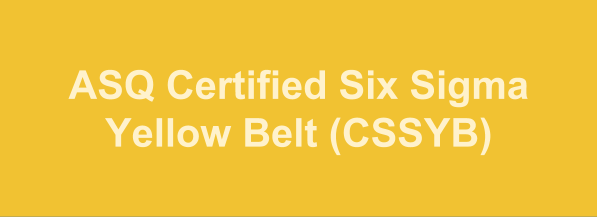Certified Six Sigma Yellow Belt (CSSYB)
ASQ CSSYB Exam Summary:
| Exam Name | ASQ Certified Six Sigma Yellow Belt |
| Exam Code | CSSYB |
| Exam Fee | USD ASQ MEMBERS - $322 NON-MEMBERS - $422 RETAKES - $222 |
| Exam Duration | 138 Minutes |
| Number of Questions | 90 |
| Passing Score | 550/750 |
| Format | Multiple Choice |
| Books | Six Sigma Yellow Belt Certification Preparation The ASQ Certified Six Sigma Yellow Belt Handbook, this study guide - Second Edition |
| Sample Questions | ASQ Six Sigma Yellow Belt Exam Sample Questions and Answers |
| Practice Exam | ASQ Certified Six Sigma Yellow Belt (CSSYB) Practice Test |
ASQ Six Sigma Yellow Belt Syllabus Topics:
| I. Six Sigma Fundamentals (20 Questions) | ||
| A. Six Sigma Foundations and Principles | - Describe the purpose of Six Sigma (reducing variation), its methodology (DMAIC), and its evolution from quality. Describe the value of Six Sigma to the organization as a whole. (Understand) | |
| B. Lean Foundations and Principles | - Describe the purpose of lean (waste elimination) and its methodologies (just-in-time, poka-yoke, kanban, value stream mapping). Describe the value of lean to the organization as a whole. (Understand) | |
| C. Six Sigma Roles and Responsibilities | - Define and describe the roles and responsibilities of Six Sigma team members (i.e., individual team members, Yellow Belt, Green Belt, Black Belt, Master Black Belt, process owner, champion, sponsor). (Understand) | |
| D. Team Basics |
1. Types of teams 2. Stages of development 3. Decision-making tools 4. Communication methods |
|
| E. Quality Tools and Six Sigma Metrics |
1. Quality tools 2. Six Sigma metrics |
|
| II. Define Phase (14 Questions) | ||
| A. Project Identification |
1. Voice of the customer 2. Project selection 3. Stakeholder analysis 4. Process inputs and outputs 5. Supply chain management |
|
| B. Project Management (PM) Basics |
1. Project charter 2. Communication plan 3. Project planning 4. Project management tools 5. Phase reviews |
|
| III. Measure Phase (15 Questions) | ||
| A. Basic Statistics | - Define, calculate, and interpret measures of central tendency (mean, median, mode) and understand measures of dispersion (standard deviation, range, variance). (Apply) | |
| B. Data Collection |
1. Data collection plans 2. Qualitative and quantitative data 3. Data collection techniques |
|
| C. Measurement System Analysis (MSA) |
1. MSA terms 2. Gauge repeatability and reproducibility (GR&R) |
|
| IV. Analyze Phase (17 Questions) | ||
| A. Process analysis tools |
1. Lean tools 2. Failure mode and effects analysis (FMEA) |
|
| B. Root cause analysis | - Describe how the 5 Whys, process mapping, 8D, force-field analysis, and matrix charts can be used to identify the root causes of a problem. (Understand) | |
| C. Corrective action | - Explain and apply elements of the corrective action process: identify the problem, contain the problem (interim action), determine the causes of the problem and propose solutions to eliminate it or prevent its recurrence (permanent action), verify that the solutions are implemented, and confirm their effectiveness (validation). (Apply) | |
| D. Preventive action | - Explain and apply elements of a preventive action process: understand various process analysis techniques to identify potential failures, defects, or process deficiencies; improve the process (e.g., understand error- or mistake-proofing devices or methods, initiate procedural changes), and verify the effectiveness of the preventive action. (Apply) | |
| E. Data analysis |
1. Basic distribution types 2. Common and special cause variation |
|
| F. Correlation and regression |
1. Correlation 2. Regression |
|
| G. Hypothesis testing | - Define and distinguish between hypothesis terms (i.e., null and alternative, type I and type II error, p-value and power). (Understand) | |
| V. Improve and Control Phases (14 Questions) | ||
| A. Improvement techniques |
1. Kaizen and kaizen blitz 2. Plan-do-check-act (PDCA) cycle 3. Cost-benefit analysis |
|
| B. Control Tools and Documentation |
1. Control plan 2. Control charts 3. Document control 4. Work instructions and standard operating procedures (SOPs) |
|





0 comments:
Post a Comment